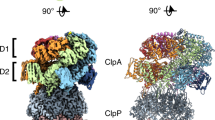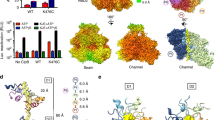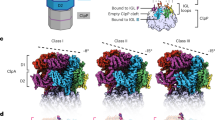Abstract
ATP-dependent proteases of the AAA+ family, including Escherichia coli ClpXP and the eukaryotic proteasome, contribute to maintenance of cellular proteostasis. ClpXP unfolds and translocates substrates into an internal degradation chamber, using cycles of alternating dwell and burst phases. The ClpX motor performs chemical transformations during the dwell and translocates the substrate in increments of 1–4 nm during the burst, but the processes occurring during these phases remain unknown. Here we characterized the complete mechanochemical cycle of ClpXP, showing that ADP release and ATP binding occur nonsequentially during the dwell, whereas ATP hydrolysis and phosphate release occur during the burst. The highly conserved translocating loops within the ClpX pore are optimized to maximize motor power generation, the coupling between chemical and mechanical tasks, and the efficiency of protein processing. Conformational resetting of these loops between consecutive bursts appears to determine ADP release from individual ATPase subunits and the overall duration of the motor's cycle.
This is a preview of subscription content, access via your institution
Access options
Subscribe to this journal
Receive 12 print issues and online access
$189.00 per year
only $15.75 per issue
Buy this article
- Purchase on Springer Link
- Instant access to full article PDF
Prices may be subject to local taxes which are calculated during checkout






Similar content being viewed by others
Change history
07 October 2016
In the version of this article initially published online, a reference to Iosefson et al. was omitted. The error has been corrected for the print, PDF and HTML versions of this article.
References
Moore, S.D. & Sauer, R.T. Ribosome rescue: tmRNA tagging activity and capacity in Escherichia coli. Mol. Microbiol. 58, 456–466 (2005).
Gottesman, S., Roche, E., Zhou, Y. & Sauer, R.T. The ClpXP and ClpAP proteases degrade proteins with carboxy-terminal peptide tails added by the SsrA-tagging system. Genes Dev. 12, 1338–1347 (1998).
Kim, Y.I., Burton, R.E., Burton, B.M., Sauer, R.T. & Baker, T.A. Dynamics of substrate denaturation and translocation by the ClpXP degradation machine. Mol. Cell 5, 639–648 (2000).
Baker, T.A. & Sauer, R.T. ClpXP, an ATP-powered unfolding and protein-degradation machine. Biochim. Biophys. Acta 1823, 15–28 (2012).
Martin, A., Baker, T.A. & Sauer, R.T. Diverse pore loops of the AAA+ ClpX machine mediate unassisted and adaptor-dependent recognition of ssrA-tagged substrates. Mol. Cell 29, 441–450 (2008).
Martin, A., Baker, T.A. & Sauer, R.T. Pore loops of the AAA+ ClpX machine grip substrates to drive translocation and unfolding. Nat. Struct. Mol. Biol. 15, 1147–1151 (2008).
Siddiqui, S.M., Sauer, R.T. & Baker, T.A. Role of the processing pore of the ClpX AAA+ ATPase in the recognition and engagement of specific protein substrates. Genes Dev. 18, 369–374 (2004).
Sen, M. et al. The ClpXP protease unfolds substrates using a constant rate of pulling but different gears. Cell 155, 636–646 (2013).
Maillard, R.A. et al. ClpX(P) generates mechanical force to unfold and translocate its protein substrates. Cell 145, 459–469 (2011).
Aubin-Tam, M.-E., Olivares, A.O., Sauer, R.T., Baker, T.A. & Lang, M.J. Single-molecule protein unfolding and translocation by an ATP-fueled proteolytic machine. Cell 145, 257–267 (2011).
Chistol, G. et al. High degree of coordination and division of labor among subunits in a homomeric ring ATPase. Cell 151, 1017–1028 (2012).
Moffitt, J.R. et al. Intersubunit coordination in a homomeric ring ATPase. Nature 457, 446–450 (2009).
Adachi, K. et al. Coupling of rotation and catalysis in F1-ATPase revealed by single-molecule imaging and manipulation. Cell 130, 309–321 (2007).
Hersch, G.L., Burton, R.E., Bolon, D.N., Baker, T.A. & Sauer, R.T. Asymmetric interactions of ATP with the AAA+ ClpX6 unfoldase: allosteric control of a protein machine. Cell 121, 1017–1027 (2005).
Glynn, S.E., Martin, A., Nager, A.R., Baker, T.A. & Sauer, R.T. Structures of asymmetric ClpX hexamers reveal nucleotide-dependent motions in a AAA+ protein-unfolding machine. Cell 139, 744–756 (2009).
Stinson, B.M. et al. Nucleotide binding and conformational switching in the hexameric ring of a AAA+ machine. Cell 153, 628–639 (2013).
Baird, C.L., Harkins, T.T., Morris, S.K. & Lindsley, J.E. Topoisomerase II drives DNA transport by hydrolyzing one ATP. Proc. Natl. Acad. Sci. USA 96, 13685–13690 (1999).
Sharma, S. & Davidson, A.L. Vanadate-induced trapping of nucleotides by purified maltose transport complex requires ATP hydrolysis. J. Bacteriol. 182, 6570–6576 (2000).
Chemla, Y.R. et al. Mechanism of force generation of a viral DNA packaging motor. Cell 122, 683–692 (2005).
Schnitzer, M.J. & Block, S.M. Kinesin hydrolyses one ATP per 8-nm step. Nature 388, 386–390 (1997).
Martin, A., Baker, T.A. & Sauer, R.T. Protein unfolding by a AAA+ protease is dependent on ATP-hydrolysis rates and substrate energy landscapes. Nat. Struct. Mol. Biol. 15, 139–145 (2008).
Martin, A., Baker, T.A. & Sauer, R.T. Rebuilt AAA + motors reveal operating principles for ATP-fuelled machines. Nature 437, 1115–1120 (2005).
Iosefson, O., Nager, A.R., Baker, T.A. & Sauer, R.T. Coordinated gripping of substrate by subunits of a AAA+ proteolytic machine. Nat. Chem. Biol. 11, 201–206 (2015).
Wang, M.D. et al. Force and velocity measured for single molecules of RNA polymerase. Science 282, 902–907 (1998).
Glynn, S.E., Nager, A.R., Baker, T.A. & Sauer, R.T. Dynamic and static components power unfolding in topologically closed rings of a AAA+ proteolytic machine. Nat. Struct. Mol. Biol. 19, 616–622 (2012).
Keller, D. & Bustamante, C. The mechanochemistry of molecular motors. Biophys. J. 78, 541–556 (2000).
Visscher, K., Schnitzer, M.J. & Block, S.M. Single kinesin molecules studied with a molecular force clamp. Nature 400, 184–189 (1999).
Iosefson, O., Olivares, A.O., Baker, T.A., & Sauer, R.T. Dissection of axial-pore loop function during unfolding and translocation by a AAA+ proteolytic machine. Cell Rep. 12, 1032–1041 (2015).
Olivares, A.O., Nager, A.R., Iosefson, O., Sauer, R.T. & Baker, T.A. Mechanochemical basis of protein degradation by a double-ring AAA+ machine. Nat. Struct. Mol. Biol. 21, 871–875 (2014).
Kenniston, J.A., Baker, T.A., Fernandez, J.M. & Sauer, R.T. Linkage between ATP consumption and mechanical unfolding during the protein processing reactions of an AAA+ degradation machine. Cell 114, 511–520 (2003).
Acknowledgements
We thank the members of the Bustamante laboratory S. Liu, R. Gabizon, and S. Tafoya for helpful discussions. We also acknowledge M. Sen, K. Nyquist, and R. Maillard for the data obtained with ATP-γS. This research was supported by NIH grants R01GM071552 and R01GM032543 (C.B.; mechanochemistry of molecular motors), NIH grant R01-GM094497 (A.M.; ATP-dependent protein degradation by AAA+ proteases), the Searle Scholars Program (A.M.), the Howard Hughes Medical Institute (C.B. and A.M.; laboratory infrastructure and support) and the US Department of Energy Office of Basic Energy Sciences Nanomachine Program, under contract no. DE-AC02-05CH11231 (C.B.; optical-tweezers development).
Author information
Authors and Affiliations
Contributions
P.R.-A. designed, performed and analyzed most of the experiments with input from C.B. and A.M. L.R. and F.K. contributed to most of the experiments and assisted with cloning, protein purification, and part of the data acquisition with optical tweezers. P.R.-A., C.B., and A.M. wrote the manuscript.
Corresponding authors
Ethics declarations
Competing interests
The authors declare no competing financial interests.
Integrated supplementary information
Supplementary Figure 1 ATP-hydrolysis-based switching model.
(a) Distribution of burst sizes (n = 1154 bursts) and dwell durations (n = 1060 dwells) for increasing ratios of ATPγS / ATP concentrations. The arrows indicate the bursts whose populations increase (1-nm burst) or decrease (4-nm bursts) with increasing ATPγS concentration. (b) For a particular cycle, binding of ATP to the two high-affinity sites and ATPγS to the two low-affinity sites would lead to a 2-nm burst followed by an ATPγS-induced pause. During this pause, the two post-hydrolysis subunits would release their ADP, the two subunits already pre-bound with ATPγS may switch to become the high-affinity sites8, and one or two of the four then empty subunits could bind ATP with low affinity. The onset of the subsequent burst would be determined by the off-rate of ATPγS from the high-affinity sites, which explains the observed pause duration of more than 1 s, and the burst size would again be at maximum 2 nm, contributed from the ATP-hydrolyzing subunits.
Supplementary Figure 2 Effect of increasing VO43– concentration on the ATPase rate and translocation velocity of WT ClpXP.
(a) ATPase rate of WT ClpXP is shown as a function of the ATP concentration in the presence of 500 μM titinCM-ssrA at different VO43- concentrations. The data were fitted to the Michaelis-Menten equation. Error bars indicate standard deviations resulting from three independent experiments. (b) Dependence of the density and duration of pauses on VO43- concentration (mean ± s.e.m.) at 5 mM ATP. (c) Distribution of dwell durations (n = 1060 dwells) and bursts sizes (n = 1154 bursts) for increasing VO43- concentrations.
Supplementary Figure 3 ATP binding and ATP hydrolysis in the dwell–burst cycle of ClpXP.
(a) Possible scenarios for ATP binding and ADP release within the dwell/burst cycle of ClpXP. (b) Left: ATPase rate of WT ClpXP and GYVG mutants is shown as a function of the ATP concentration in the presence of 500 μM titinCM-ssrA. Data were fitted to the Michaelis-Menten equation. Error bars indicate standard deviations resulting from three independent experiments. Right: kinetic parameters of WT ClpXP and GYVG mutants obtained from the fittings in the left panel.
Supplementary Figure 4 GYVG mutations affect the chemical and mechanical operation of the motor.
(a) Density and duration of translocation pauses for GYVG mutants (mean ± s.e.m.) at 5 mM ATP. Numbers indicate positions of mutated subunits in the ClpX hexamer. (b) ATPase rates of GYVG mutants in the absence of protein substrate (basal ATPase rates). Rates have an error of approximately ± 5% based on replicate measurements (n = 3). (c) Correlation of the pause-free velocity (mean ± s.e.m.) of GYVG mutants as a function of their corresponding dwell duration.
Supplementary Figure 5 GYVG-loop mutations change the frequency and duration of sequence-induced pauses.
(Top) Pause-frequency distribution for WT ClpXP as it translocates the GFP moiety of the GFP-titin fusion substrate Fig. 1c in the main text. The GFP portion includes an N-terminal Ybbr tag of 18 amino acids, such that the cyclic GFP chromophore is located at position 84 instead of 66. The region surrounding the cyclic GFP chromophore is underlaid in light blue. The positional resolution of this ClpXP translocation analysis is 10-15 amino acids. (Bottom) Residence times along the GFP sequence for WT ClpXP and its Y153A and V154F pore-loop mutants. Each line represents a single-molecule trace of GFP substrate translocation (nWT = 37 traces; nVF = 28 traces; nYA = 42 traces). Residence times above 0.5 s (which corresponds to the mean residence time plus two standard deviations) are considered pauses. Compared to WT ClpXP, V154F mutants with larger GVYG loops show a significantly higher frequency of translocation pausing in the GFP region around the chromophore, whereas Y153A mutants with smaller-size GYVG loops pause as infrequently as throughout the rest of the GFP substrate (see Fig. 5d in the main text).
Supplementary Figure 6 GYVG mutations affect the dwell duration of the motor.
(a) Left: Burst-size distribution at 5 mM ATP for GYVG mutants bearing Y153A or V154F mutations in three subunits. The arrows indicate the presence of 4-nm bursts. Right: Dwell-duration distribution of representative GYVG mutants. (b) Effect of limiting ATP concentrations on the dwell duration and burst size of the YA14 mutant. The arrows indicate the presence/absence of 4-nm bursts. (n = 414 dwells and 381 bursts).
Supplementary information
Supplementary Text and Figures
Supplementary Figures 1–6 (PDF 1580 kb)
Rights and permissions
About this article
Cite this article
Rodriguez-Aliaga, P., Ramirez, L., Kim, F. et al. Substrate-translocating loops regulate mechanochemical coupling and power production in AAA+ protease ClpXP. Nat Struct Mol Biol 23, 974–981 (2016). https://doi.org/10.1038/nsmb.3298
Received:
Accepted:
Published:
Issue Date:
DOI: https://doi.org/10.1038/nsmb.3298
This article is cited by
-
Extreme parsimony in ATP consumption by 20S complexes in the global disassembly of single SNARE complexes
Nature Communications (2021)
-
The molecular principles governing the activity and functional diversity of AAA+ proteins
Nature Reviews Molecular Cell Biology (2020)
-
Topologically knotted deubiquitinases exhibit unprecedented mechanostability to withstand the proteolysis by an AAA+ protease
Scientific Reports (2018)



